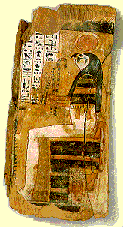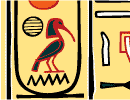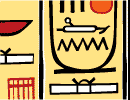Gods and Religion

 The ancient
Egyptians interpreted every occurrence in terms of the relationship
between natural and supernatural forces.
The ancient
Egyptians interpreted every occurrence in terms of the relationship
between natural and supernatural forces.
Those phenomena that
figured prominently in their lives included the annual cycle of the Nile
River's flood, the enormous size and unchanging harshness of the
surrounding desert, and the daily cycle of the sun's appearance in the
east, gradual movement across the sky,  and eventual disappearance in the west. The ancient Egyptians
developed a world view in which these and other events and conditions were
attributed to the actions of multiple, related gods and goddesses.
and eventual disappearance in the west. The ancient Egyptians
developed a world view in which these and other events and conditions were
attributed to the actions of multiple, related gods and goddesses.
The ancient Egyptians imagined the world to be a far different place
from what we now know it to be. They believed the earth was a flat
platter of clay afloat on a vast sea of water from which the Nile River
sprung. In this fundamental description of the world, the forces of nature
were identified as divine descendants of the creator god.
When we try to make some sense out of the many Egyptian gods and
goddesses, we must  keep two important facts in mind. First, early in
Egyptian history Lower (north) and Upper (south) Egypt were unified under
one ruler. This union resulted in the merging of several cultural
traditions. Second, because ancient Egyptian civilization existed for more
than three thousand years, the deities and myths gradually changed over
time as a result of new ideas, contact with other peoples, and changing
cultural values.
keep two important facts in mind. First, early in
Egyptian history Lower (north) and Upper (south) Egypt were unified under
one ruler. This union resulted in the merging of several cultural
traditions. Second, because ancient Egyptian civilization existed for more
than three thousand years, the deities and myths gradually changed over
time as a result of new ideas, contact with other peoples, and changing
cultural values.
One of the best-known legends in Egyptian mythology,
for example, revolves around a deity who at one time may have been a local
ruler in the Nile River's delta. Originally Osiris was a
god associated with the city of Busiris in the Delta; over time this
regional god gained countrywide acceptance.

As the religion of Egypt evolved, various gods gained
importance. The falcon-headed god depicted on this coffin
fragment is identified as Re-Horakhty-Atum, the god central in
creation myths. Re, the sun god, had several aspects: Khepri, the morning;
Horakhty, the midday; and Atum, the afternoon. During Dynasty XXI (ca.
1070-945 B.C.) with increasing frequency he replaced Osiris in the
traditional offering formula.





